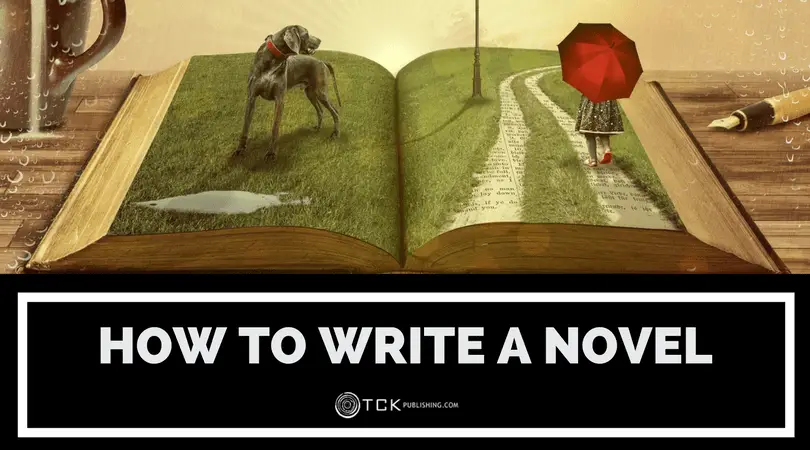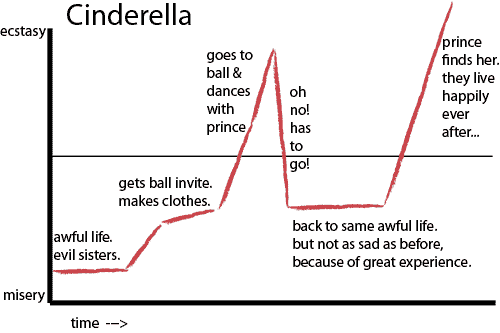Ask a random person on the street what their biggest unfulfilled dream is, and odds are many of them will say, “I want to write a novel.”
More than 80% of people aspire to write a book someday—but never get around to it.
If you want to learn how to write a novel and are actually ready to get started, you’re in the right spot.
How to Write a Novel
There are many reasons why you might not take the plunge and put off writing the novel that’s been spinning in your head for months or even years.
You might think you don’t have the time; you might not have been the best student in English class; you might be afraid of what your friends and family will think.
But if you have the passion and drive to write, you should!
Everyone can learn the skills they need to become a better writer, entertain their audience, and write the very best novel they have within them.
And with the publishing revolution of the past few years, anyone who’s willing to put in some time and effort can find a path to getting published.
Whether you choose to pursue a traditional agented deal, go with a small press, or self-publish, you can learn how to write a novel that readers all over the world will be eager to devour.
It’s an incredibly exciting time to be a writer! The trick is, you have to actually get started.
With that in mind, we’ve created a guide to writing your novel that can help you get going and remove the barriers to your dream.
The 5 Essential Steps of Writing Your First Novel
Now that you understand the key elements of a novel, it’s time to get started creating one! Here’s how to write a novel in 5 essential steps.
1. Develop a Story Concept
The first step to writing your novel is creating the concept for your story. Your story concept is the underlying idea that your novel is built on.
What do you want to convey to readers through your novel? What themes do you want to tackle? What’s your goal in writing this book?
Your answers to these questions will shape your novel throughout the process, so it’s worth thinking them through at the very beginning.
You probably already have a pretty solid concept for your novel. Maybe you want to write an inspiring tale of romance that redeems its characters and reaffirms readers’ faith in love. Maybe you want to sweep readers into a thrilling tale of political intrigue that leaves them asking questions about the current state of affairs in the world. Maybe you just want to give them an escape to a magical world where dragons serve tea every day at four.
All of these are great novel concepts!
Take a few minutes to think about what you want to do with your novel—inspire, educate, entertain, provoke, escape—and how you might best do that with your writing. Jot down a few of those themes and goals and use them to help guide you through the writing process.
What tone do you want to take? Serious, funny, provocative, informative, uplifting…? Find the voice that speaks to you and your goals for this novel and its readers.
2. Read Extensively in Your Genre
Whether or not this is your first go at writing, you should make sure you have a thorough knowledge of your genre before starting your novel.
This means if you’re writing a romance novel, you should spend your downtime reading plenty of romance. Take note of both the good and the bad. Get familiar with some of the most common tropes from your genre.
Genres are important because they tell readers what they can expect from a story. For example, if a reader picks up what was marketed as a romance novel only to find the main characters wrapped up in a murder mystery leading one of them to their tragic death and zero chance of a Happily Ever After, they’re bound to be a little pissed.
Study the best examples of writing in your genre, learn what your readers want, and find a fresh way to give it to them.
3. Build Your Setting
Our environments shape how we act, what we think, what we focus on, and what we value. In the case of speculative fiction, in particular, the environment or setting can almost become a character in its own right. For example, strange science-fiction or fantasy worlds are full of intricate detail and unusual elements that make them incredibly challenging (and rewarding) to create.
Historical settings, too, can become virtual characters of their own, loaded with details and nuances that astute readers will appreciate.
Worldbuilding, as the creation of a setting is known, can be one of the most fun parts of writing a novel. But it can also be a little overwhelming—sometimes, in fact, authors get stuck on building the world and never move on to actually writing the story!
Here’s a few ways to get started with creating the setting for your novel.
Use Experiences to Reveal the World
The old principle “show, don’t tell” is key here. Much like with creating characters, building a world is all about finding a balance between giving too much description and too little.
When in doubt, don’t tell the reader everything about the setting—drop in little hints as you go, such as what a character sees out of the corner of her eye or what another smells as he rounds a corner. Let us experience the world through your characters rather than explicitly telling us what to imagine.
Tips for Worldbuilding
You may want to consider making a spreadsheet, Word doc profile, or visual inspiration board for your setting. This is especially helpful when creating a sf/f setting or working in a historical context—having a way to organize your research and setting development can ensure that you keep everything straight and have it ready to access when you need to refer to it during the writing process.
It’s also important to make sure that your settings are unique enough that your reader can identify them—it’s confusing and a bit boring if everything is set in the same generic courtyard or sterile room (unless, of course, that’s part of the plot!).
Smooth over Your Research
While it’s admirable to do great background work in creating your setting, putting so much care and attention into the details of your world can also backfire when you start writing.
Many authors have a tendency to “show their work,” especially in sf/f and historical novels. They’ve worked hard to create a vivid setting and they want to show that off!
This creeps into their writing in the form of lengthy paragraphs of detailed background research in historical novels, noting the exact style of the plasterwork or the date a certain light fixture was first introduced.
In sf/f novels, you see it in the form of long asides on the epic history of the world, details on a specific plant or animal that appeared in the background, or extended descriptions of cultural practices.
For the most part, these long descriptions don’t add to the story—they explain background elements that the author has worked hard to learn or create, but they don’t advance the plot, help a character’s growth, or otherwise add to the reading experience.
Smooth over your research and background wherever you can. Ask yourself every time you’re tempted to put in background information: Is this really necessary? How does it move the plot forward?
4. Develop Your Characters
Characters are key to any novel—a series of descriptions of places or events that don’t feature any actual people (or trolls, or talking dogs, or hyper-intelligent plants, or…you get the picture) just won’t engage your readers.
People are social creatures; we like to think about, talk about, and engage with other people.
So the cornerstone of any great novel is great characters.
Great characters, mind you, aren’t perfect people—in fact, the best characters are inherently flawed.
Avoid Absolutes, Stereotypes, and Perfect Characters
Absolutely perfect characters are often referred to as “Mary Sues” and “Gary Stus”—you know the type, with perfect hair, sparkling eyes (often an unusual color), and they’re very relatable but incredibly popular and beloved by everyone who meets them.
They’re also boring as heck, and usually a beginning author’s attempt to either create a likeable main character or live out some wish fulfillment of their ideal self.
In reality, we all have our faults and flaws, and the most engaging characters also show these traits. Maybe your hero has a bad habit of talking over other people. Maybe your heroine is impatient and easily frustrated. Maybe one character picks his nose, or always leaves the toilet seat up.
Flaws, quirks, bad habits, and foibles all make your characters more believable, and make it easier for your readers to relate.
Avoiding perfection goes for your antagonists and villains, too—no villain is ever perfectly evil. Remember, “We’re all the hero of our own story.” So perhaps your dastardly evildoer, who’s always trying to thwart your hero, also visits her elderly grandmother every week with homemade soup.
The more human and relatable your characters are, with a full store of good and bad qualities that come out in the course of the novel, the more engaged your readers will be, because they’ll see some of themselves or someone they recognize in your characters.
Make Characters Individuals
Another key to building great characters is to make them individuals. This goes along with the flaws and quirks—every character should be instantly recognizable as a unique person.
Every person has a motivation—a reason for doing what they do. Some are after power; some want recognition. Others want to be helpful, or fit in with a group, or achieve some particular goal.
Kurt Vonnegut once said, “Every character should want something, even if it’s a glass of water.”
What do your characters want? Give them individual motives and desires and allow that to shape who and what they become in the course of your story.
Tips for Character Creation
With these guidelines in mind, you can start shaping the characters for your novel.
Make Character Profiles
Make a character profile for each of your main and supporting characters. You can also create a Pinterest board with imagery and quotes that relates to your mental image of your character.
Try out different names, jot down character traits (handsome but with a squint, loyal, easily frustrated, etc.), and keep tabs on how the characters relate.
Borrow from Life
Art imitates life, and you should feel free to borrow character traits, speaking patterns, foibles and flaws, and more from people you know or interact with in real life.
It’s probably not a great idea to drop your boss right smack into your horror novel as Murder Victim #1, complete with the same name, personality, and job title, but you can borrow elements of people you know to help create more realistic characters.
This tip also applies when writing dialogue: you want your characters to speak like real people do, not sound stiff or forced, and so borrowing speech patterns from conversations you hear around you every day (complete with contractions, slang, and other “improper” language elements) can help make your novel even more engaging.
5. Choose a Point of View
Once you have a general idea of your storyline and main characters, you should choose a point of view from which to tell your story.
The lens through which you choose to present your story can have a huge impact on how it unfolds and how readers relate.
Do you want to stick to an all-knowing, third-person omniscient narrator? This offers advantages and disadvantages. Similarly, choosing a character to tell the story from the first person point of view offers a very unique perspective, with many benefits and setbacks of its own.
Before you start writing, think carefully about how you want your story to be told and by whom. Consider the benefits and drawbacks for every option, then choose the one that offers your readers the best experience.
6. Shape the Story Arc
You’ll often hear about the “three-act structure” or the “narrative arc” when discussing how to write fiction.
But what do these really mean?
A story arc is the overall shape of your novel. It refers to the rising and falling of tension or emotion, and to the development and successful conclusion of your plot.
The great Greek philosopher Aristotle once said that “A whole should have a beginning, middle and an end.” This is definitely true of your novel!
That said, the beginning of your novel doesn’t have to be the beginning of the story. It can be very effective to pick up the action in the middle of things, a technique called in medias res.
Basically, you jump straight into the action, immediately making your readers want to know what happened to get to this point, and where things are going from here.
That brings us into the overall structure of a good novel. These elements are often called different things by different people, but engaging stories always contain each of these elements to some degree:
- Hook
- Conflict
- Escalation
- Setback
- Overcoming
- Resolution
Some common story arcs leave out one or more of these elements, and some common arcs handle them in slightly different ways—for instance, the resolution doesn’t always have to be happy (a satisfying end to a novel might be a sad one), and so you might not have the “overcoming” phase in that sad story.
The exact pattern of your story arc will depend on your novel concept, your plot, and what you want to accomplish with your story. But at the very least, you should include:
- Hook
- Conflict and Tension
- Resolution
The Hook
The hook is the first thing your reader will see. It’s the opening of your novel, the “can’t put it down” intro that makes them just have to keep reading.
This may be the most important bit of the book, because it will determine whether your readers keep reading.
This is why the in medias res technique is so powerful. When you start in the middle of the action, a reader’s instinct is to want to know what’s happening, why it’s happening, and where it’s going to go from here.
You don’t have to open every novel with a slam-bang action scene, though. Your hook can be more character-driven, too—you can drop us into a moment in the daily life of your main character that gives us a glimpse into who they are as a person, thus hooking us to want to know more about them.
7. Establish Conflict and Raise the Stakes
A story that doesn’t go anywhere isn’t very satisfying, and it’s certainly not a lot of fun to read.
A great story, in contrast, is one where stuff happens. Characters go off on an adventure—or go on a spiritual or personal journey within themselves while seemingly staying put in their lives. The key is that there’s movement of some sort, whether that’s character growth or actual journeys.
There are tons of different ways to approach conflict and tension in your novel.
You might be penning a more literary work where the conflict is internal: the main character is struggling with some great question and has to find her way to clarity and growth.
Or you might be writing an epic space adventure where the conflict is between two sprawling intergalactic empires, both seeking interstellar dominance.
Maybe it’s something in between, where the conflict is between two people, perhaps a gruff rancher and the beautiful real estate developer who wants to put condos next door.
Clearly, there’s room for conflict and tension at every level, and every scope.
Raising the Stakes
The trick here is that your conflict and tension should ratchet up over the course of your story arc.
Start off with a hint of that conflict right at the beginning, so we know something interesting is going to happen. Add a little more tension, then a little more, raising the stakes as you go. Wind things tighter until you stick your characters in a really hard spot that they have to figure their way out of.
That hard spot, the key turning point where your characters’ decisions and actions will make the difference in how the story goes from there, is the climax of your novel, and it’s what everything you’ve been doing is building towards.
Once you hit that tipping point, you’re heading on your way to the resolution.
But it doesn’t need to be a smooth journey from hook to climax to resolution!
Your novel can have a bumpy story arc instead of a smooth one. In fact, this often makes for the most engaging novels!
Consider having several small mini-climaxes before your main climax—put your characters in a few sticky situations and have them deal with them before getting to the key turning point.
Running in Parallel
You can also keep your readers engaged by running multiple story arcs at the same time. You can have one big overall arc, with one or two sub-plots moving alongside it and within it.
This can be very complicated to do, and hard to keep track of all the moving parts, but when it works, it’s dynamite!
Whenever the action slows with one set of characters or one aspect of the plot, you can keep things chugging along by having a sub-plot ready to go and switching to that mini-arc to repeat the process of creating a hook, raising the tension, hitting the climax, and creating resolution.
Resolution
When we finish a story, we want to feel satisfied—we want to know that something happened and that it’s wrapped up.
Otherwise, something just feels undone or incomplete.
Be sure that your story has a logical resolution: everything that the rising tension has led to comes to a head, ultimately concluding with a scenario that makes sense given everything that’s come before.
This isn’t always a happy ending; all the conflict and drama could turn out such that the main character meets his downfall in some way.
The key is that readers will feel satisfied if things are wrapped up in a way that makes sense given everything that’s happened in the story.
Wrapping It Up: A Warning
This is an area of caution for fiction authors who are creating series: it’s often tempting to leave certain elements unresolved—to not tie up all the loose ends so that you have a ready-made hook for the next book in the series.
But failing to provide a solid resolution won’t entice your readers to pick up the next book; it’ll annoy them, because they feel they’ve been cheated out of an ending.
Think about how you can leave some loose ends dangling to make your reader want to know more, to dive deeper, without leaving them on a cliffhanger at the end of the book.
You might, for instance, resolve your main story arc, but leave one or two sub-plots unresolved, hinting that you’ll pick them up in the next book.
Maybe the main characters defeated the villain, but he got away to fight another day. Perhaps the romantic leads fell in love and got married, but there’s a hint of conflict yet to come because they never did work out the drama with her sister.
Resolve your main source of conflict in a logical and satisfying way, but leave a few threads ready to pick up in the next book. Readers who love what you did in this novel will be eager to follow to the next, knowing that you can craft a satisfying story from start to finish.
Tips for Shaping a Story Arc
One of the best ways to figure out the pacing and shape of your story arc is to draw it.
Kurt Vonnegut once diagrammed the arc and flow of the classic fairy tale Cinderella to show why it’s had such a lasting impact on literature.
We can map out the initial setup, the tension and conflict of being forbidden to go to the ball, the escalation of preparing for the event, the turning point of dancing with the prince, the setback of fleeing and losing her slipper, and the overcoming phase of being identified by the prince and living happily ever after in a solid resolution.
Those ups and downs are what make for a gripping plot and story arc.
Consider diagramming out your own plot to see where you can add some setbacks, overcome obstacles, or otherwise turn a boringly smooth arc into something jaggedly exciting.
8. Write an Outline
Now that you’ve created characters, built a setting, and mapped out your story arc, it’s time to buckle down to the heady business of writing!
To help you do so, you should create an outline before you really start putting words down.
Consider the good ol’ 5 Ws (and an H):
- Who
- What
- When
- Where
- Why
- How
We’ve already covered several of these in our prep work tips for how to write a novel.
You know who is involved—your characters. You know when and where things are happening—your setting. You have the basics of what is going to happen—your story arc. And you know why it’s all taking place—your concept.
Fill out the how and you’ve got yourself a novel!
9. Experiment with Literary Techniques and Devices
What makes many of the best works of literature so great is the authors’s skilled use of literary devices and narrative techniques.
This doesn’t mean you need to shove metaphors and similes into every crevice of your story. (In fact, an overreliance on such devices can be the mark of a novice writer.)
However, a good use of irony or foreshadowing can go a long way to make a compelling story.
10. Establish a Writing Routine
With your trusty outline in hand, all that’s left to do is start writing your novel. Easy, right?
Well, unless you’re already a #1 bestselling author with a huge platform, you probably still have a day job, or other day-to-day obligations, like your family or other hobbies.
Life happens, and often, these day-to-day duties will keep aspiring writers from finishing their first novel. It becomes a pipe dream, doomed to sit in their desk drawer for eternity, something you’ll get around to “someday” when you “have the time.”
The good news is that with some careful planning, you can make time, as long as writing your novel is truly a priority for you.
No, you don’t need to (and shouldn’t!) quit your day job. Instead, set your alarm clock one hour earlier every morning to get your writing in while you have some quiet time to yourself. Or, if you’re more of a night owl, switch off the late-night talk shows for a while and work on your manuscript.
Develop a strong writing routine that you can realistically maintain. Just a little time every day can help you make loads of progress.
11. Revise and Seek Feedback
When the first draft of your manuscript is complete, print a few copies for some friends, family, or colleagues whose opinions you trust.
They don’t need to be aspiring authors themselves; just having a fresh set of eyes on your work can help you identify plot holes, areas in need of greater development, or other issues that you didn’t notice because you were too close to your writing.
Before you send your work off to a professional editor or a literary agent, make sure that you’ve done some diligent editing yourself and made your manuscript the best it can possibly be. Asking for feedback and insight from others can certainly help you get there.
What to Do Next
Once you’ve finished writing your novel, it’s time to find an editor and study how to get your book published!
Then, create a master marketing plan for your book, starting with some thorough market research.
Did you find this post helpful? Let us know in the comments below!
For more great guides to the world of fiction, read on!
- How to Publish a Book
- How to Write Better Fiction and Become a Great Novelist
- How To Earn a Full-Time Income Writing Fiction Books
Kate Sullivan is an editor with experience in every aspect of the publishing industry, from editorial to marketing to cover and interior design.
In her career, Kate has edited millions of words and helped dozens of bestselling, award-winning authors grow their careers and do what they love!








Hi, Kate.
Good to have you here. Thanks for making novel writing inviting and attractive. I have learnt a lot from this write up.
I know you shall be of great help to me and a dozen of my works.
Love what you are doing. Stay blessed
I’m so glad you found Kate’s article helpful, Michael! Best of luck with your writing :)